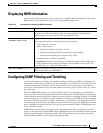
22-19
Catalyst 2960 and 2960-S Switch Software Configuration Guide
OL-8603-09
Chapter 22 Configuring IGMP Snooping and MVR
Configuring MVR
When a subscriber changes channels or turns off the television, the set-top box sends an IGMP leave
message for the multicast stream. The switch CPU sends a MAC-based general query through the
receiver port VLAN. If there is another set-top box in the VLAN still subscribing to this group, that
set-top box must respond within the maximum response time specified in the query. If the CPU does not
receive a response, it eliminates the receiver port as a forwarding destination for this group.
Without Immediate Leave, when the switch receives an IGMP leave message from a subscriber on a
receiver port, it sends out an IGMP query on that port and waits for IGMP group membership reports. If
no reports are received in a configured time period, the receiver port is removed from multicast group
membership. With Immediate Leave, an IGMP query is not sent from the receiver port on which the
IGMP leave was received. As soon as the leave message is received, the receiver port is removed from
multicast group membership, which speeds up leave latency. Enable the Immediate-Leave feature only
on receiver ports to which a single receiver device is connected.
MVR eliminates the need to duplicate television-channel multicast traffic for subscribers in each VLAN.
Multicast traffic for all channels is only sent around the VLAN trunk once—only on the multicast
VLAN. The IGMP leave and join messages are in the VLAN to which the subscriber port is assigned.
These messages dynamically register for streams of multicast traffic in the multicast VLAN on the
Layer 3 device. Switch B. The access layer switch, Switch A, modifies the forwarding behavior to allow
the traffic to be forwarded from the multicast VLAN to the subscriber port in a different VLAN,
selectively allowing traffic to cross between two VLANs.
IGMP reports are sent to the same IP multicast group address as the multicast data. The Switch A CPU
must capture all IGMP join and leave messages from receiver ports and forward them to the multicast
VLAN of the source (uplink) port, based on the MVR mode.
Configuring MVR
These sections contain this configuration information:
• Default MVR Configuration, page 22-19
• MVR Configuration Guidelines and Limitations, page 22-20
• Configuring MVR Global Parameters, page 22-20
• Configuring MVR Interfaces, page 22-21
Default MVR Configuration
Table 22-5 shows the default MVR configuration.
Table 22-5 Default MVR Configuration
Feature Default Setting
MVR Disabled globally and per interface
Multicast addresses None configured
Query response time 0.5 second
Multicast VLAN VLAN 1
Mode Compatible


















